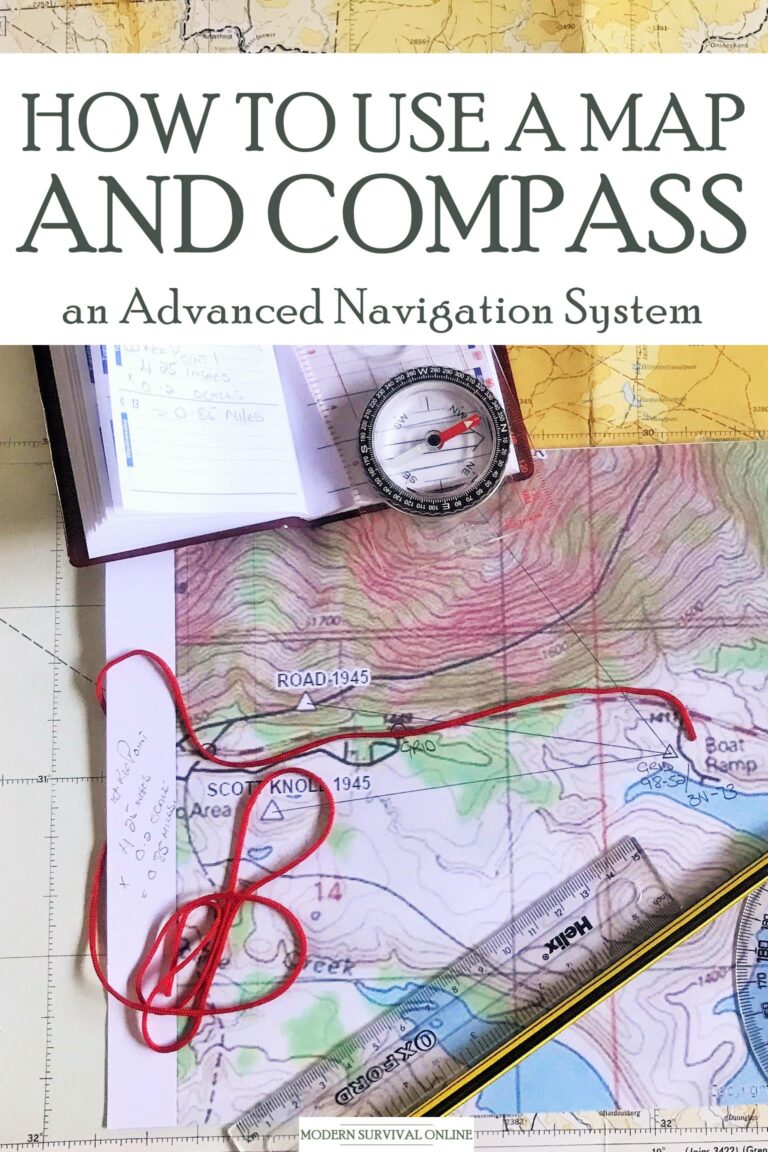You are familiar with the use of a compass and a map, and their supporting roles in defining navigation.
Maps and compasses are simple to use, so don’t be overwhelmed by the huge amount of information out there.
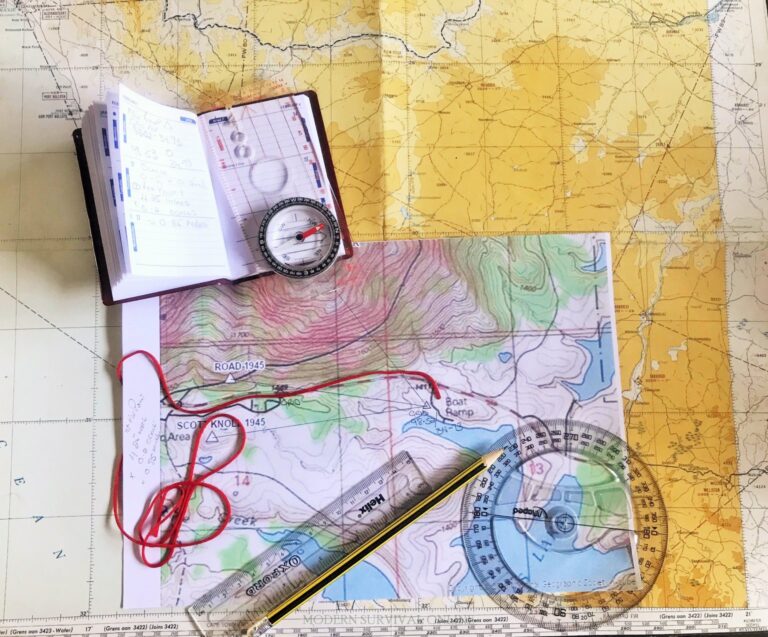
A map can only give you a relative bearing or direction, and a compass only a direction or bearing but no knowledge of the terrain and its features.
Combined, they make a formidable navigation aid, which with use will become natural and easily handled. I will outline some fundamentals and bolt on skills that you can add to your navigation tool box.
This article will show you how to use a map and compass to avoid getting lost, and to get you to where you want when you don’t have modern technology at your disposal.
The Basics
Map
- Topographic map of the area or areas you will be moving through. For USA maps your free downloads can be found at the United States Geographic Survey or USGS.
- Map of your area in the relevant scale 1:24000 1 inch is equal to 24000 inches on the ground or 1:25000/1:50000 1 centimeter on the ground is equal to 250000 or 50000 cm on the ground.
- Taking scale into account, the smaller the scale the more defined the Topographical Map and the more cluttered.
- Contour lines indicate height and gradient. They never cross.
- Store in a waterproof Ziploc bag or laminate. If you fold, reinforce the folds.
- The Map is a representation of the ground and the ground a representation of the map
- The top of the map is always North.
- Maps will give you the relevant Magnetic North Declination (ensure it is up to date)
- Familiarize yourself with the legend.
Compass
The compass can be used for accurate position determination. These are the two types of compasses that will serve you well for navigation and orienteering:
- The Baseplate Compass
- The Baseplate Mirror Compass
That being said, let’s keep these in mind about compasses:
- Magnetic North will always draw the Compass Needle to its point of reference.
- Check your compass regularly for accuracy.
- The rotating bezel can be dialed in to compensate for declination and define the bearing True North.
- Use the compass to orientate the map.
- The Compass will have a magnification lens fitted to read map features easily.
Using the Map and Compass Together
These basics will see you right in case of a navigational emergency, what this article will do is provide you with the method to stay on course, making navigation more accurate and easier to apply the basics.
The map and compass work together in a symbiotic relationship, supporting one another in confirming position and orientation of the map to the ground and your physical position in relation to the ground and map.
Keep in mind the acronym A B C which stands for Align, Bearing, Course.
Align
- The Compass and The Map – Place the map on a flat surface, draw a line from your position to the reference point you wish to move to.
- Align the compass long edge along the line.
Bearing
- Rotate the Bezel Dial until you have boxed the magnetic needle on North – Red in The Shed.
- The Degree at the base of the Travel Arrow is your bearing.
- You are now orientated on the point you wish to move to.
Course
- Lift your compass, orientate your body by moving it to align with the Magnetic North or True. North if you have allowed for Magnetic Declination.
- The Travel Arrow will show the direction you must move in, your course.
Positioning
Map Cross Reference
Take a look at the “map” below. What unique and identifiable features are immediately available to you and can you identify them?

Some of the things that jump out immediately:
- The Mountain Feature is prominent
- The Lake
- The Farm House
Orientate the Compass to True North using the map to identify delineation.
Take a bearing to each of the features from your position.
The three bearings are your cross-reference points. Drawing a line on your map from each point until they intersect – the point where they cross over each other. That is your position on the map.
Align. From this point you can accurately Align yourself to the ground and fix your position on the map. This is your known starting point.
Bearing. If you have to move from this point to a given reference point or rendezvous point, you can take a Bearing to this point with the compass giving you a visual queue on which to walk.
Course. Plot the Course on your map by drawing a straight line from your fix to the reference point, irrespective of topographical features. This is your map bearing to your next point.
Trigonometric Beacons, Verified Heights, and Surveyors Beacons
Maps record trigonometric surveyors’ beacons. They are identified by position numbers, and are placed on the highest land features in an area. They are used for defining a single point on the earth’s surface as referenced by the map coordinates.
These surveyors’ beacons or Trigonometrical beacons are very useful and provide accurate points of reference.
They are spread throughout the entire country and represented on your map as Spot Heights or Trigonometric Beacons representing a specific height.
The USGS topographical maps do not show Surveyors Beacons as the information cannot be verified. The National Geodetic Survey is the agency that undertakes the verification of heights and land features.
The information is detailed and can be accessed on the site, the explorer option gives you historical data and GPS verified beacons. Validated markers are pinpointed on the maps and you can cross reference using the onsite tools here.
The top of the map is always North, align the compass along the maps grid lines. This is with or without taking magnetic declination into account.
Declination will impact your bearings on the ground; however, you are working with the map only and using the compass to find or read off the map bearings using the maps declination as reference.
The triangulation to these points from your position will fix your position on the ground and on the map.
Lifting the diagram off the above map to simplify, orientate the map to ground using the features you can see. Your map will be orientated to True North.
Standing at the boat ramp, draw three lines through the three markers on the map, the point at which they intersect is your position on the map. Plot your fix using the maps grid reference.
Shooting the bearings with the compass will give you 3 points of reference to fix your position and which you can use later when you move of so write them down.
These are dominant reference points that are obvious from the ground. The road and the boat ramp are a balancing feature, it gives your fix a solid reference on the map.
Pencil in your position with a triangle, then shoot the bearings to the grid reference your position:
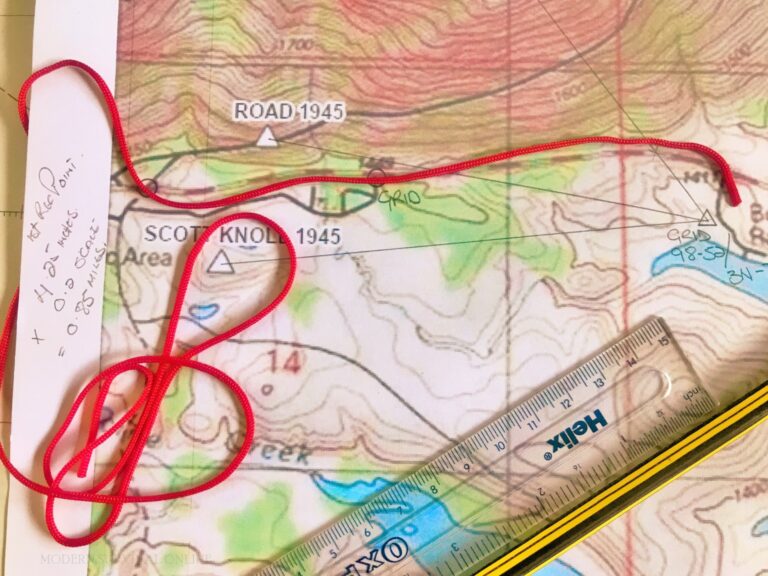
Remember Three for Me – Three Bearings to Find your Position
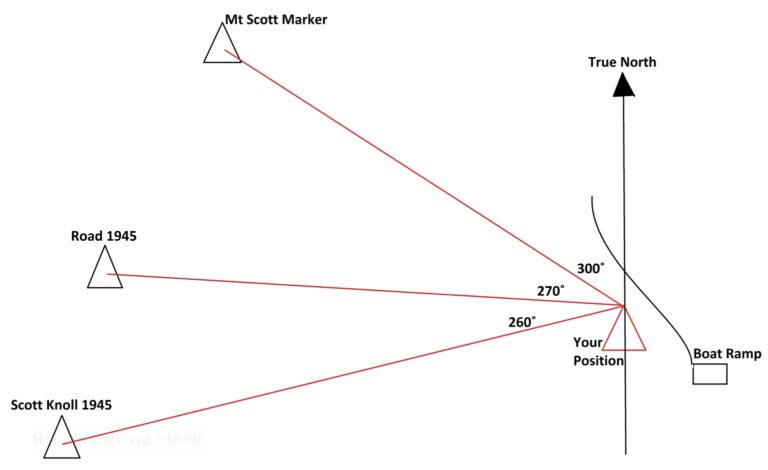
Deciphering Topographic Contours
The topographic map shows the contours in relation to the surrounding ground layout. If you want to plan a hike or bug out through an area, knowing where you are going is paramount.
Before you start your journey, these questions require answers:
- What you will encounter?
- How you will traverse through the area?
- Where are my reference points?
- What are my catch points?
- Features I can use as handrails?
- Distance per Day
- Gradients
- Critical Features
Your questions are not limited, they are dependent on YOUR needs. A stroll down to the jetty is not the same as planning an overnight traverse of a valley or a climb up to the summit of Mt Scott.
I follow a military maxim that was drilled into my core, it is an overlay that should council your decisions and help you to tackle any eventuality and maximize your experience.
Everything you do, every decision you make will impact the quality of the experience.
Let’s take a look at how a couple of hours of map orientation and familiarity will impact what you eat, what cloths you wear, the backpack you take, the water you drink, ultimately the enjoyment you derive from taking a stroll with nature.
Orientating Yourself on A Map
You are secure in the knowledge that you know where you are, now to figure out the route to where you are going.
Using your map, you want to walk to where the road crosses the rail line, this is your reference point. The fastest route is to follow the rail line to this point, this is your route and your handrail.
If you tray from your course, you can always rely on the rail line to guide you onward and be your catch point if you wonder off to far.
You see an interesting old structure and deviate from your route to take a look. If return on the path you took to get to the structure you will walk into the rail line, it will catch you. From here its easy to re-orientate yourself and carry on to your reference point.
How far will you walk if the scale is 1 inch on the map is 24000 inches on the ground, written as 1:24000.
Using the lanyard string from the compass, lay it out along your route from your fixed position all the way along your route taking the twists and turns that can see, as in roads or paths etc.
Arriving at your first way point, this is the visual reference point that you can see from your fix. Take a bearing to this point along a straight line, so when on the move you can sight along the travel arrow of your compass to ensure you are still on track.
Using the string, lay it out along your ruler to establish the exact length then measure the distance against the maps scale.
Tip: Have some Blu Tack (also called Prestik) stored in a small lip gloss tub – place small bits along the route and press the string into it to hold it in place, especially around bends. Do not pull or stretch the string it will throw out you’re reading.
If in inches, your distance will be in feet and miles. If in centimeters the distance will be measured in meters and kilometers.
Now that you have established your distance, you can set off confidently.
Contours
Your topographic map is an aerial view of your surroundings, so how do you create a 2D view of the map for reference purposes?
The key is the topographic lines and the distance between them, the topographic interval is the guide to the slope and its degree of gradient.
Useful Tip: Even though straight up is the shortest route, it is the most difficult and will burn your bodies’ reserves to conquer the steep slope. Paths, including game paths follow the contours and ascend in a circular route, it would seem longer but will save your energy and will save you time.
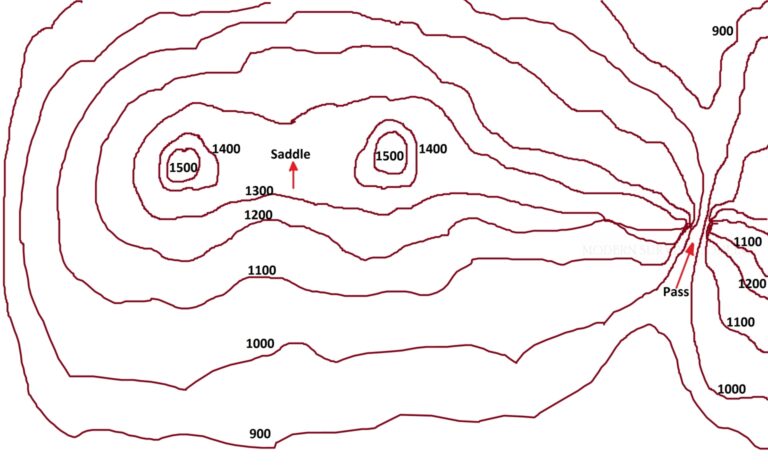
The contour intervals indicate a progressive rise in 100 feet or meters, depending on the map you are using.
The contours are moving from 1100 to the top of the hill to 1500; that’s an increase of 400 feet or meters.
- If A, is the top of the hill and B is your point below, the contour lines between are close together indicating a steep slope, not one to tackle due to the steep gradient.
- If A, the top of the hill and C is your point below, the contour lines between are further apart indicating a gentler slope, with a steep midpoint. This could be a route taken, however the energy it will sap may count against you.
- If A, is the top of the hill and D is your point below, the contour lines between are widely spaced indicating a gentle slope, this would be a prime route to ascend to the top of the hill as its gradient is a gentle increase gradient.
It is now possible to establish a gradient profile using a cross section of the contour intervals.
Doing this exercise will help you to establish land features as the appear on the ground, familiarizing yourself with your map using profiling will sensitize you to map features.
Circumstance may dictate you move fast, that will entail making snap decisions, your life and any with may depend on it.
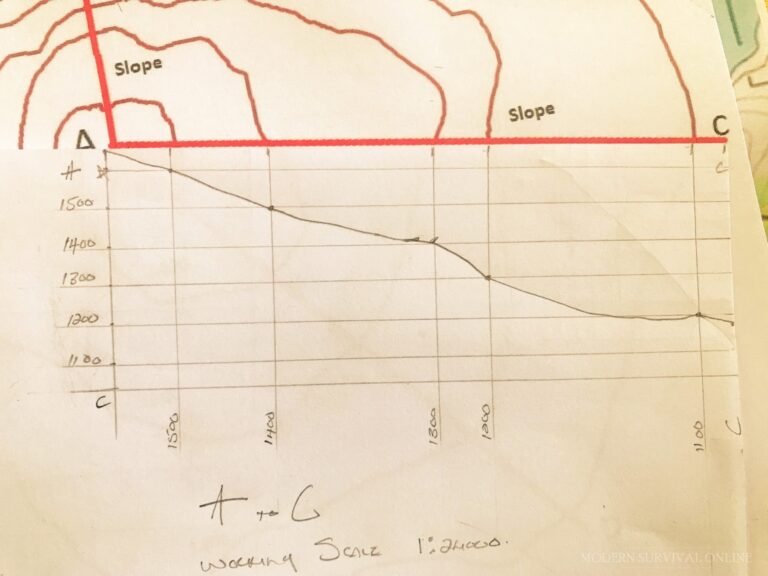
Using a blank piece of paper, run it along the line you have drawn from point A to point C. From A mark off the index contour lines as they appear on the map.
The contour points will give you the horizontal reference points on the ground.
Use the scale of the map, 1:24000, these points as your vertical reference in inches.
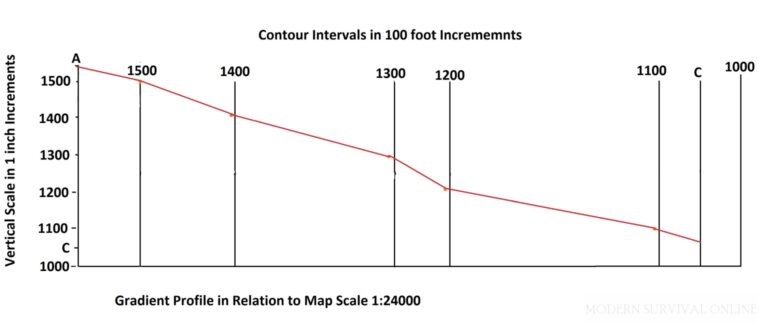
Taking the profile of Point A to Point B you can see the difference in the slope; the gradient is steeper and not a safe option.
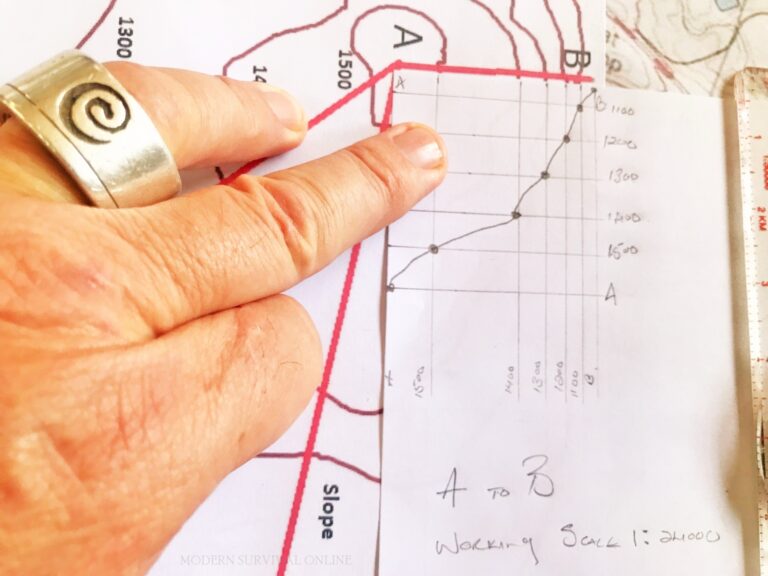
Contour profiling gives you a visual representation of what you will face on the ground.
Important Features On A Map
Rivers and Waterfalls
Rivers and waterfalls are represented on your map by the contour lines.
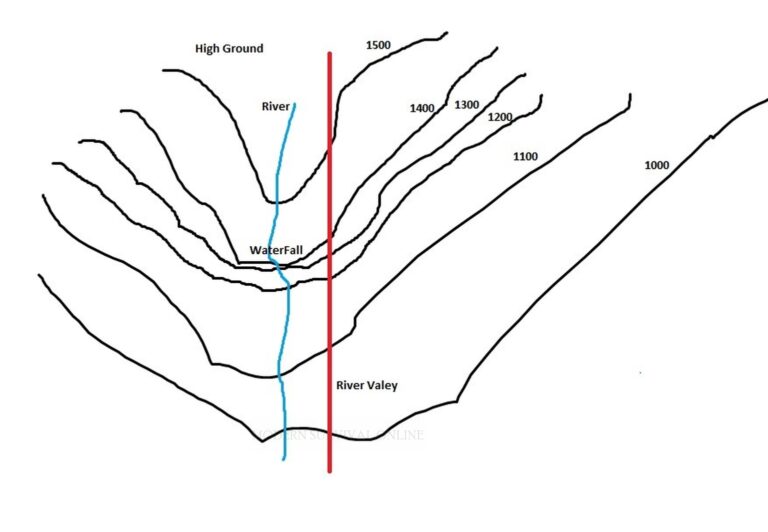
V is the Key – the downward point indicates that the topographic contours are representing a River Valley.
The contours that close on each other, they are almost touching, will represent a waterfall.
The further apart the contours the gentler the slope and so the gentler the flow of the river, steep slopes give water speed.
Spurs and Ridges
A ridge is a long narrow hilltop or watershed as rain runs off its slopes It is also called the ridgeline, the long narrow outline silhouette outlined against the sky.
A spur is another ridge or hill that runs off laterally from the main feature.
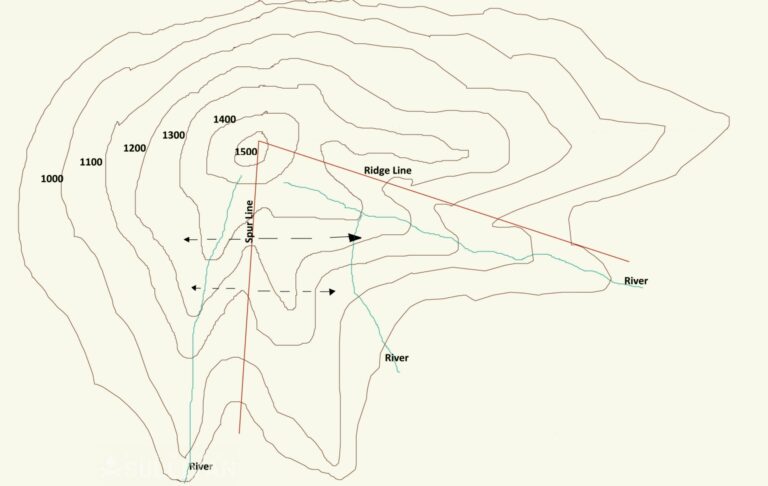
Remember the V is Key – Inverted the V represents a ridge, a sharp top line running out from the summit of the hill of mountain.
If you need to cross a mountain range as part of an expedition or a way out of an emergency situation, you will need to find the best route possible. The most accessible and a path exposing you to the least possible risk.
Passes and Saddles
A saddle is the lowest point between two high points on a mountain range or it splits a ridge allowing access to the area beyond the ridgeline.
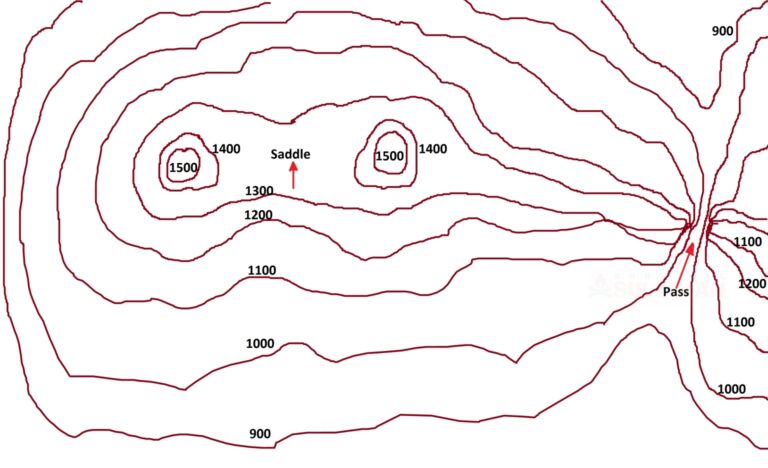
Looking at a Mountain Range you will easily identify the Saddle and the Mountain Pass. When planning your route, the pass may seem inviting and if unobstructed would be an option.
Water likes the easiest route and can erode the path making it steep, slippery and heavily wooded.
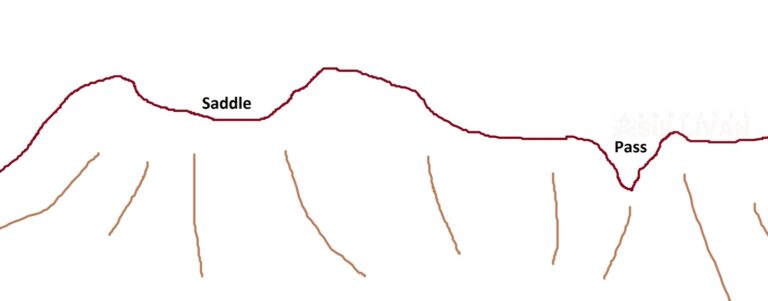
On The Move
You are navigating everyday of your life, going to work, driving across town, finding the bathroom in the dark, friendships, social interactions, work and business.
Everything requires a map and compass; some things are learned like knowing your way to work, and some require an attention to detail like hiking the Grand Canyon.
As with most things, the human condition wants to know and we map our lives with an attention to detail. So it is with mapping geography.
There are “life hacks” that we can use for both:
- Map Orientation with Compass
- Map Orientation to the Land Features
- Catch Features
- Handrails
- Reducing the clutter – Working with the main features
- Shooting a Bearing
- Back Bearings (Safety Bearing)
- Negotiating Obstructions
- Pacing
- Folding and Thumbing the Map
- Using the Maps Symbols Effectively
- Advanced Dead Reckoning
Catch or Collecting Features
Moving between points on the ground to reach your destination details plotting a course. Your course will have multiple reference points that you will use to guide you on your way.
On a map it’s as simple as point A to point B…
However, on the ground with its hills and valleys, boulders and rivers and a number of other obstructions you will have to plot your course, between, over and around these.
Point A as a starting point will require navigation to various points called catch points along your route, literally visual points that you can see that you will navigate to and will “catch “you and point you the next catch point on your route.
Handrails
As with a staircase, the handrail is there to guide you on your journey, it’s a safety device you can refer to, to keep you from losing your way and ensuring you can recognize terrain features and catch points.
Plotting your route on the map provided you will find a number of land features that will help guide you on your way.

- Orientate Map to the Ground
- Use the Compass to Orientate the Map
- Plot a straight line from A to B on the Map
- Shoot a Bearing to Point B to get a travel bearing
- Note the Map Features
- Identify them on the ground
Map Features
As you can see from the map, there is a hill in the direct line to point B and a footpath is indicated on the map.
Identify the major features on the map and the ground, discard minor features, like the swamp next to the lake.
Stay focused on the main features and their orientation to your position. Look back to recognize them if you have to back track.
Using the hill as a catch point, take a bearing from your fix to the Hill, and walk in that direction. Even if you go slightly off course due to unseen obstacles, the hill will catch you if you are off course.
The lake is a visible point from most directions, you can use it as a handrail. It’s on your right side, the hill is in front of you.
Keeping your direction with the compass to the hill and the lake on the right you are now orientated to the major land features that will keep you on track.
Even without the compass you can quick reference your Lake Handrail to stay on course.
Once at the Hill, you can move towards the lake to navigate around the Hill as shown on the map, and pick up the trail that is outlined.
Another example would be if the bridge was your first reference point. You want to use it to cross the river easily, and not expose yourself to the hazards of a fast-moving water source to get to your next point.
The bridge is however hidden in the river valley and cannot be seen from your vantage point, the hill now becomes your catch point from where you can find the track that will allow you to find the bridge.
Orientate your map once you hit the catch point and mark its location, as you head off to find the track look back, if you overshoot you can always find your way back to a known point and start again.
What happens if you can’t find the trail? Well, you have a general idea of where the bridge is, it’s over the river and from the hill you take a bearing in its general direction as you take a heading from your map.
The river is an excellent catch point, but it can be confusing if you hit the river with no bridge in sight. The question is left or right, it’s an upstream, downstream thing. If you know the direction of flow.
Orientate Yourself
At this point you could move into a depression that obscures the lake, refer to your map. Its easy to take a wrong turn here, as paths or trails encourage us to take their course. If you can see the bridge, orientate yourself with your map to the ground.
Use your compass to ensure you are on the correct bearing to Point B.
You can see the river on your right, this will now become your next handrail as you navigate to your next point.
The map shows a path that runs through the forest, shoot a bearing to the forest edge, and if you keep to the path, you can orientate your self to the forest edge as a catch point.
The approach to Point B has a swamp on the left and a hill on the right, the map indicates that the path weaves its way through these two obstacles. You are still using the river as your handrail and can use it to navigate your way.
This portion of your trek could be the hardest: the swap level may have risen due to heavy rain, the path could be overgrown with lack of use or washed away. Its important to keep a bearing on Point B.
If you are completely disorientated, you can use your safe bearing or the back bearing.
Moving on the trail you are using, maintain visual contact with your major land features, if you leave the trail to negotiate an obstacle, you can use it to back track if you hit a non-navigable dead end, say a swamp hole or deep mud.
Leaving the trail, note your feature and shoot a bearing to it, if you need to back track and can’t see it, you can use your compass to orientate yourself to the last bearing you shot. Three-meter-high reeds can “blind” you, DO NOT PANIC, refer to your compass, you have got this.
On the Move Pacing
You need to set out now, its time to move, light is going and your rendezvous with the hiking club is at Point B. Plotting the course, using the string and the map scale you know its approximately 3.8 kilometers to you destination including negotiating the hill and following the paths circuitous route.
Using the track at the sports ground where you live, you have figured out your pace over a given distance, taking into account that the track is a level and even surface. Your pace rate per 100 meters is 67 right side paces per 100 meters.
You can cover 100 meters at a brisk walk in 90 seconds or 1.3 minutes – that’s 13 minutes a kilometer on the flat track. Taking terrain into account you have been able to maintain this pace over hard uneven terrain.
3.8 Kilometers x 13 minutes = 49.40 minutes
Distance (Ground distance A to B) x Speed (Time per kilometer) = Time (Total time to Point B)
Taking variance into consideration, that time that unseen obstacles can add to your initial calculation. Stops to admire the view, orientate at catch points, drink water etc.
Variance can add up to 10% to your travel time on average 49.4 minutes to destination plus 10% is 54,34 minutes.
I always round up and give myself enough time between points, minutes count but taking a wrong turn can add hours. Even if you are in a rush check your numbers, recheck bearings and land features.
That said you are now ready and there is a simple yet effective map practice that will shave time off your trip, the technique is called thumbing the map.
Folding and Thumbing the Map
You know where you are and you know where you are going, the whole map is not relevant right now, so fold it.
Fold it along the other edges parallel to your route, leaving only the relevant details of the map exposed. The land features on your route are memorized and you have had a good look around to associate the map with the ground.
Every time you change direction to follow a different leg, refold the map to parallel your next course line.
Keep your thumb on your fix, your starting point and as you move along let your thumb move along the course you plotted in relation to the land features you are familiar with. This method will save you time by reducing stops to check your position.
It will help you zoom in on your position without having to take in the whole map and realign it with the general ground features.
Handy Tip: Draw an Arrow on your thumb nail it will help you maintain direction:
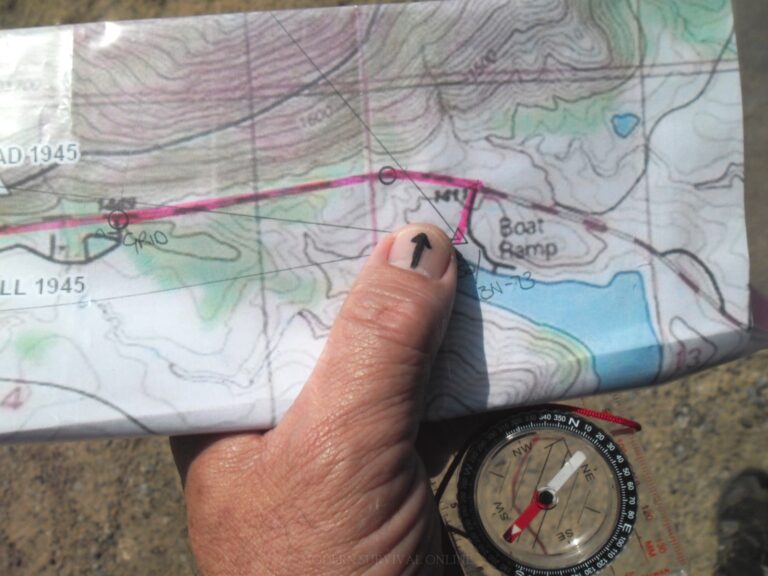
Don’t let go of the map, even if you get distracted or fall, you will be able to quickly reorient and find your way.
It is important to practice this method in familiar surroundings to build confidence and ensure your safety.
Handy Tip: A mnemonic for you to remember: DDT Catches Flies = Distance Direction Terrain Catching Features
Using the Maps Symbols Effectively
Using the maps symbols identify the map features, mark them and memorize them. I personally draw my own map with these features on, ensure it can overlay with the original map.
This, bare bones map will be a precision tool to ensure I don’t get side tracked and helps me remember my route, even without a map.
Keys to Navigation
The best teacher is practice, its your excuse to get out, enjoy nature, explore your neighborhood, and learn new things.
Navigation is a fundamental skill; it is your security in finding your way and making life an enjoyable experience.
The Keys as outlined in this article are your map and compass, they unlock navigation and with practice will become so natural that in many cases you will automatically know which way you are going.
Familiarize yourself with the basics of both, learn the information on your maps and practice patience in your work.
Trust yourself, if you are unsure take a moment. Rather lose half an hour, see it as a rest for your body, than lose hours finding your way again or worse, getting totally lost.
- Learn your A, B, Cs
- Three For Me
- Remember DDT Captures Flies
Most importantly, have patience with yourself and others, don’t panic and have fun.
